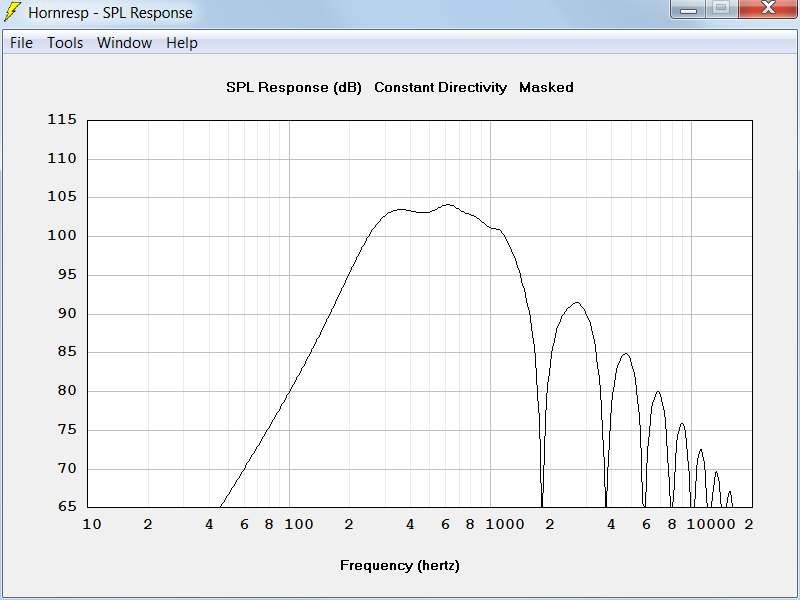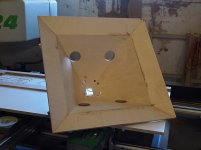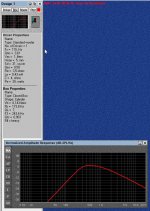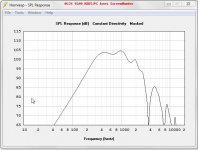Exactly....and with a 4" overall body diameter AND extending away from the throat with a plane wave tube, I suspect you could get the outlet of each mid MUCH closer to the throat that with cone drivers sans little 2" or less types.....which don't have much power handling anyways.
It's not about trying to shove the mids as close to the comp driver as we can. There's a method to this madness.......here's some notes I sniped from a post by JLH:
JLH said:Few notes about what I’ve found to work, and what doesn’t work too well in a Unity style horn.
1.) You can greatly reduce the effects of the mid range entry ports on the compression driver’s frequency response by making careful engineering choices. When I’m designing the crossover points between the mids and compression driver, I leave them very flexible. What you should shoot for is a situation where the following is true : The expansion rate (flare frequency) that the compression driver “sees” must be lower in frequency than the actual crossover frequency. i.e. – If the flare rate is 900Hz, then your crossover frequency must be above 900Hz.
2.) The compression driver’s crossover point dictates where the mids should tap into the horn. Example -If the compression driver’s crossover is 1500Hz, then the mids need to tap into the horn where the cross-sectional area is 41.54 cm2 or LARGER. It’s not about just trying to get the mids as close to the compression driver as possible. Because the compression driver is low passed at 1500Hz, the cross-sectional area where the circumference is equal to 1 wave length – any area larger than this becomes acoustically invisible to the compression driver. This is because the compression driver is cutoff at 1500Hz – thus its output cannot create acoustical pressure against the horn walls when the cross-sectional area is larger than 41.54 cm2. This pretty much removes the effects of the mid entry ports on the compression driver’s frequency response.
I think the fact that Danley's Synergy horns can do linear phase without DSP shows that the cone drivers located correctly can work very well. I'd also guess if mid comp drivers worked better he would have used them........though thinking outside the box is never a bad thing!
I wonder myself the reason Tom chose cones over CD's.....I'm sure we'll here his viewpoint at some point.
....now on my thoughts about the CD mids...IF one wanted a more compact/ for home use Synergy type, the crossover to the HF driver would need to be higher to maintain directivity ......if I'm correct? Moving the mids closer would facilitate the higher XO point.
......but quite possibly for practical purposes, there might not be a way to reduce the size to home friendly sizes.
....now on my thoughts about the CD mids...IF one wanted a more compact/ for home use Synergy type, the crossover to the HF driver would need to be higher to maintain directivity ......if I'm correct? Moving the mids closer would facilitate the higher XO point.
......but quite possibly for practical purposes, there might not be a way to reduce the size to home friendly sizes.
Keep in mind when you mount any offset driver on the side of a horn the response will be comb filtered by the throat reflection. The response of a driver with piston behavior and normal mass roll-off on the side of a constant directivity horn will look like this (centered about 2 inches from the throat end of the horn).
You only get useable response below the first notch. There is no magic to avoid this limitation.

You only get useable response below the first notch. There is no magic to avoid this limitation.

I got them from Paul also!🙂I have a dozen Celestion TF0410MR's that I bought from Paul incase he ever gets his Synergy horn kits completed. I got tired of waiting so I decided to try and build something better myself. Some day I'll do a comparison.
Send them to Red Spade. He is in the middle of it.
<snip>
And another guy trying the Celestion Mid: Mike Seddon
They use a midrang-to -horn couple design similar to the synergy, but with many small holes, claiming that the holes are reflectors to the HF through air mass in the holes and thus creating less HF interference.
That is laughable. Unless they are creating a perfect vacuum at those holes, the multiple holes will have more interference than a single intelligently placed hole. On the other hand, if they are claiming that there is a high air mass at the holes, then the interference would be even worse. The low density of air is what makes it a poor conductor of acoustic energy. By increasing the air density, the high frequencies would have an even higher affinity to be attracted to and transmitted into the holes.
That is laughable. Unless they are creating a perfect vacuum at those holes, the multiple holes will have more interference than a single intelligently placed hole. On the other hand, if they are claiming that there is a high air mass at the holes, then the interference would be even worse. The low density of air is what makes it a poor conductor of acoustic energy. By increasing the air density, the high frequencies would have an even higher affinity to be attracted to and transmitted into the holes.
Hi,
I don't know about the laughable factor, it seems to work if you look at the dispersion plots (measured by independant lab, check their website), and I can imagine that the holes are small enough to not be "seen" by the HF.
Maybe it works, maybe it doesn't, only one way to find out..

For anyone who has been through all the Beyma and 18 Sound CD's are any of them a good candidate for the SH?
I have never used these CD's so I asked if anyone thought they were any good or particular what models have been well perceived?
I was looking for a CD that could do about 1200hz crossover with moderate spl(120) and then a CD that can be used in something like a SH64. SO a CD with more SPL potential. I may have to go with BMS anyways because they seem to still be great for money. I am just wondering if Beyma and 18 Sound had any good ones because I can get those at a good cost.
A lot of options are not available because the shipping is pretty dear. SO that means they are not available because of budget is all.
I have never used these CD's so I asked if anyone thought they were any good or particular what models have been well perceived?
I was looking for a CD that could do about 1200hz crossover with moderate spl(120) and then a CD that can be used in something like a SH64. SO a CD with more SPL potential. I may have to go with BMS anyways because they seem to still be great for money. I am just wondering if Beyma and 18 Sound had any good ones because I can get those at a good cost.
A lot of options are not available because the shipping is pretty dear. SO that means they are not available because of budget is all.
Hi All
I have search some for a midrange for the synergy, I did find a visaton who has open back.
To get a better view what happens when close that back with a tube I get maybe interesting spec,s.
Visaton Full-Range FRS8-4Ohm - ElektronicaWereld.nl - Goedkoopste van Nederland
here I did calc a little closed box behind the speaker, then I get an Fs of 243 hz, so 2 x Fs / qes (if I did now the new Qes) can possible make a nice cheap mid speaker for the europian guys here.
I have search some for a midrange for the synergy, I did find a visaton who has open back.
To get a better view what happens when close that back with a tube I get maybe interesting spec,s.
Visaton Full-Range FRS8-4Ohm - ElektronicaWereld.nl - Goedkoopste van Nederland
here I did calc a little closed box behind the speaker, then I get an Fs of 243 hz, so 2 x Fs / qes (if I did now the new Qes) can possible make a nice cheap mid speaker for the europian guys here.
Attachments
Hi Guys,
check out this construction from Acoustic Line Seebug
http://www.google.nl/url?sa=t&rct=j...=jeZUmwMwnoJQ2i63a0IN0g&bvm=bv.47883778,d.d2k
They use a midrang-to -horn couple design similar to the synergy, but with many small holes, claiming that the holes are reflectors to the HF through air mass in the holes and thus creating less HF interference.
The technique is claimed to be patented also.
Interesting stuff to try out, looks like a serious engineering company.
Kees
One of the differences between the Synergy and the Unity horns is the shape of the midrange chamber; it's basically closer to a proper phase plug than in the older design.
See this page for how this affects frequency response:
Phase Plugs
Patrick, just saw this driver, not sure if it will extend high enough?
HiWave BMR12 Compact 2" Full-Range Square Speaker 12W 8 Ohm 299-208
HiWave BMR12 Compact 2" Full-Range Square Speaker 12W 8 Ohm 299-208
and this looks ok too, phase plug which should help in redicing chamber volume,
Tang Band W2-803SM 2" Extended Range Speaker Driver 264-805
Tang Band W2-803SM 2" Extended Range Speaker Driver 264-805
This one is also oke, sims good. When make a closed backroom of small dimensions we can get close to
proper Fs.
FRS 8 M - 8 Ohm
proper Fs.
FRS 8 M - 8 Ohm
Last edited:
The BMR12 is very interesting at the buyout price - I may ask a friend from the US to forward some to me. What I like about these little guys is that you can use them as a midtweet if the spirit moves you, and so compare Pluto and Synergy type speakers. Could you horn load a BMR12 directly with a square conical? Could be interesting.
I'm leaving Germany for Australia in a week. Compression drivers are harder to come by there. What do you guys think about the BMS 4538 for the tweeter. It looks like it could still reach 1000 Hz or so and is much cheaper than the 4550. For home use, it would be enough, right?
Overview
I'm leaving Germany for Australia in a week. Compression drivers are harder to come by there. What do you guys think about the BMS 4538 for the tweeter. It looks like it could still reach 1000 Hz or so and is much cheaper than the 4550. For home use, it would be enough, right?
Overview
Seems like I will be going with the 18 Sound 1460A for my CD. I am still searching for a mid since the Celestion cant be bought. May try the Celestion 5" model since it is cheap..
phase plug which should help in redicing chamber volume[/url]
One of the benefits of using a two inch driver is there is no need for a phase plug. The size of the driver and a centrally located port make it unnecessary. Path length differences are small compared to the wavelengths involved.
just saw this driver, not sure if it will extend high enough?
I would be concerned about the ability of a square flat panel to drive the high compression ratio in a synergy midrange port.
For anyone who has been through all the Beyma and 18 Sound CD's are any of them a good candidate for the SH?
I have never used these CD's so I asked if anyone thought they were any good or particular what models have been well perceived?
I was looking for a CD that could do about 1200hz crossover with moderate spl(120) and then a CD that can be used in something like a SH64. SO a CD with more SPL potential. I may have to go with BMS anyways because they seem to still be great for money. I am just wondering if Beyma and 18 Sound had any good ones because I can get those at a good cost.
A lot of options are not available because the shipping is pretty dear. SO that means they are not available because of budget is all.
I haven't tried Beyma or 18sound. But Celestion makes a number of good CDs and they're UK based. The cdx1-1745 and cdx1-1445 have been used by myself and Bill Waslo, respectively.
Thanks PB. I am going to go with the 18 Sound 1460A. I am in Australia but maybe Celestion will have a mid I can use to go with it.
- Home
- Loudspeakers
- Multi-Way
- Suitable midrange cone, for bandpass mid in Unity horn


